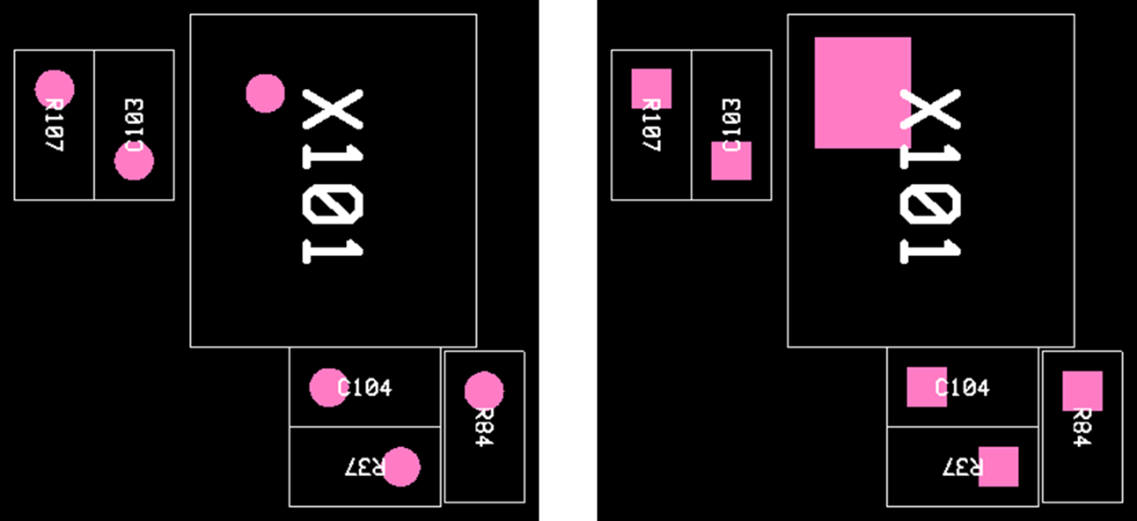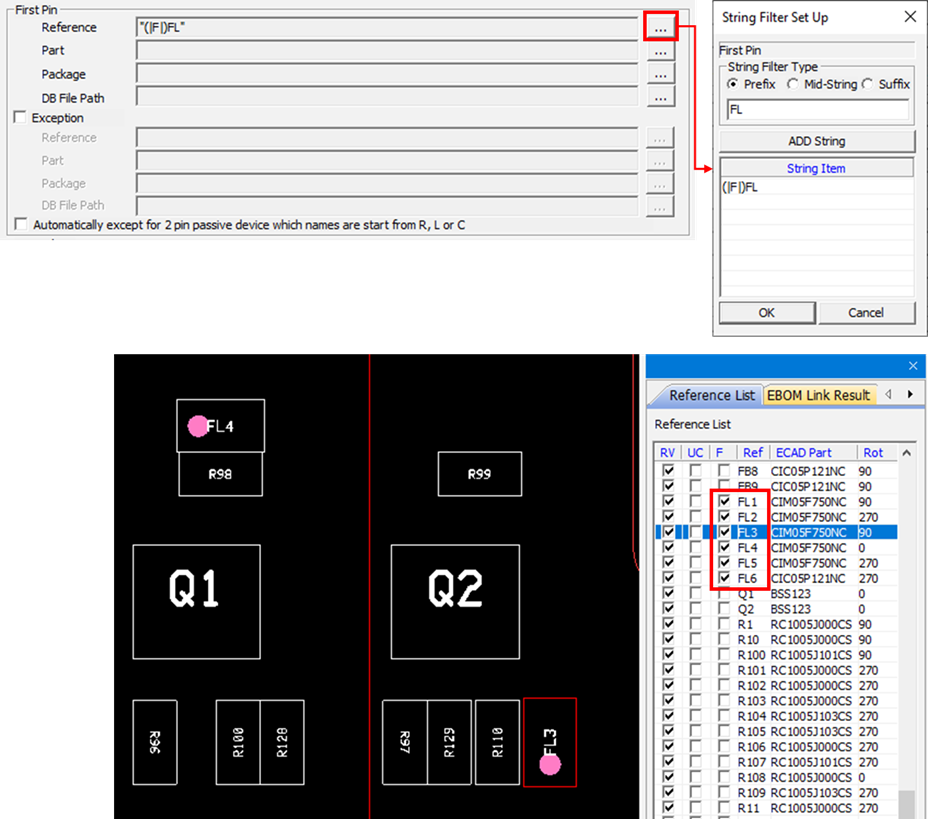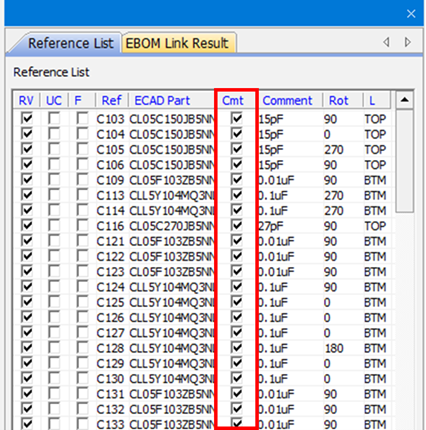CAP Data Settings
Global
Define global settings.
Default Reference Draw Option
Set the default reference area for the Top and Bottom sides.Display Option
- Board Display
- Reference Designator: Select whether to display the component.
- Pin: Select whether to display the component pin (pad).
- Pattern: Select whether to display the route.
- Silk: Select whether to display the silkscreen.
- Except Component: Exclude Reference, Part, or Package components from the display by clicking ... to open the String Filter Set Up dialog.
- In the example above, the component, which includes TP in the part name, is excluded.
- Pin Display
- First Pin: Mark the first pin position.
- First Pin-Pad Max Area: The first pin pad is marked with a pink
solid rectangle. If not selected, it displays as shown in the left
picture.

Figure 1. - Second Pin: Mark the second pin location.

Figure 2. - Pin PAD Scale: Set the marking size of the first and second pins.
- Fit Text to Area: Display the positions of the pin number one and two inside of the text area. This option only works for the two-pin part.
- Pin MaxMin: Display the pad area as a rectangle shape.
Polarity

Figure 3.
- Name
and Property Display
- Reference Name: Select whether to display the reference name.
- Part Name: Select whether to display the part name.
- Property Selection: Select whether to display the property information.
- Part Comment: Select a part property to display.
- Reference Comment: Select a reference property to display.
- Default
Text Option
- Maximum Text Size: Display at the maximum size in the test area.
- Display Text Area: Display the text area as a rectangle shape.
- Text area definition: Define the text area as a pad or COC area.
- Default Text Height: Set the text size. It will not exceed the text area.
- User Comp Data: Select whether to display the user comp data set in Other menu.
- User Comment: Select whether to display the user comment setting in Other menu.
- Upright Reading: Display the text direction according to the ratio of the text area. If the proportion of the text area is larger in the horizontal direction, the text is displayed in the left to right direction. In case of a large vertical direction, the text is displayed from bottom to top.
- Mechanical Component (No Pin): Select whether to display the parts without pin information such as a fiducial mark or a screw hole.
- Auto Zoom: Automatic zoom-in on the target part when you select a part in the reference list.
- Display CAP Setting File Name to PDF: Export the Component Arrangement Plan setting file name when printing a PDF file.
- Display CAD file created date.
Color Option
- Click the empty field next to any Item to open the Select Color dialog.
- Select a color, and then click OK.
Tool Option
- Reference List: Select whether to display the reference list dialog on the right side of the screen.
- Display Option: Select whether to display the display option dialog on the right side of the screen.
- Label Display: Select whether to display the label on upper right side of the screen.
- Label Title: A list of labels that appear on the label. You can edit the title by clicking Add or Delete.
Layer Option
- Top Layer: When displaying the top side, select the artwork layer to be displayed.
- Bottom Layer: When displaying the bottom side, select the artwork layer to be displayed.
- Display Text on Selected Layer to PDF: Option to include the part’s text of the selected artwork layer when printing a PDF.
EBOM Link Option
Specify the *.ebi file set in the PollEx BOM. Refer to BOM to learn how to create the *.ebi file.
Export Boundary to PDF
- PCB Outline: Export based on the PCB outline area.
- Component: Export including the part area placed on the PCB.
- Board Figure (Drill): Export including the figure object area placed on the PCB.
Pin Display Settings
Define pin settings.

Figure 4.
- Exception: Select a part that excludes the first pin marking.
- Automatically except for 2pin passive device which names are start from R, L, or C: Exclude the two-pin passive device automatically, which starts with R, L, and C.
User-Defined Pin
- Table
- Filter Type: Specify the filter type as either DB file or part name.
- Filter/DB File Path: Specify the filter condition or part DB file path by double-clicking the column.
- Pin Name: Specify the pin name to display as the first pin.
- Add: Add a new item to the table.
- Delete: Delete a selected item from the table.
- Edit DB: Edit a selected DB file by running the Edit Component DB. Refer to the [Appendix] Edit Component DB in this manual.
Other
Define property, user comment, and user comp data settings.
Property

Figure 5.
- Example 1) Check parts with size (width and height) over one by selecting Upper Bound.
- Example 2) Check parts with size (width and height)) less than one by selecting Lower Bound.
User Comp Data

Figure 6.
Component Group Color
- Select Type of Component Group: Select a type to define a component group among Reference Name, Part Name, Package Name, and Component DB.
- Component Group Content: Set the string filter for defining the component group.
- In the above example, parts starting with the reference name C are in a component group.
- When you select the Select Type of Component Group as DB, you can load a pre-defined component DB file from your computer. For more detailed information on how to create or edit a DB file, refer to Appendix Edit Component DB in this manual.
- Property: Display the property information of the selected component group.
- Default Comment: Enter the title of the property information to be displayed.
- Alternative Comment: To display the alternative component information, select the title of the property.
- Display Component List from User Selected Property: Create a list based on the property value and directly select whether to highlight the component.
- Visible Property in Component: Display the property value specified in the component area.
- Fill: Define the highlight color of the component.
- Display User Comment: Select whether to display the comment for the specified component group.
EBOM Link
Define the display option for components in PCB.
Display Option for Component in PCB
- Display X Mark: Display the X mark for the parts that exist only in the PCB data in the Display Value Properties. When Fill Color is activated, you can control the On/Off of the X mark in the list. • Display Exception: Exclude the component to display the X mark by using the string filter.
Polarity
Define the polarized component settings.
First Pin
Second Pin
- Second Pin: Display the polarity mark by designating the part that shows the polarity at the second pin. You can set the parts to display in the string filter dialog based on the reference, part, and package names.
User Defined Polarity Marking
- Marking Type: Select the shape of the polarity mark.
- Point: Display the polarity mark in dot. Marking position is selected among Left Top, Left Bottom, Right Top, Right Bottom, Top, Bottom, Left, Right, First Pin, or Second Pin.
- Bar: Display the polarity mark in bold lines. Marking position is selected among Top, Bottom, Left, Right, First Pin, or Second Pin.
- Arrow: Display the polarity mark in arrows. Marking position is selected either Left or Right.
- Position: Select where the polarity mark is placed. Marking position varies depending on the marking type.
- Filter Type: Set the filter type to designate the component group to display the polarity mark, which is selected among reference, part, package, or DB file.
- Filter/DB File Path: If the filter type is reference, part, or package, you can select the part having the specified string through the string filter function. If the filter type is DB file, you can select the pre-defined component DB file. For more detailed information how to create or edit a DB file, refer to [Appendix] Edit Component DB in this manual.